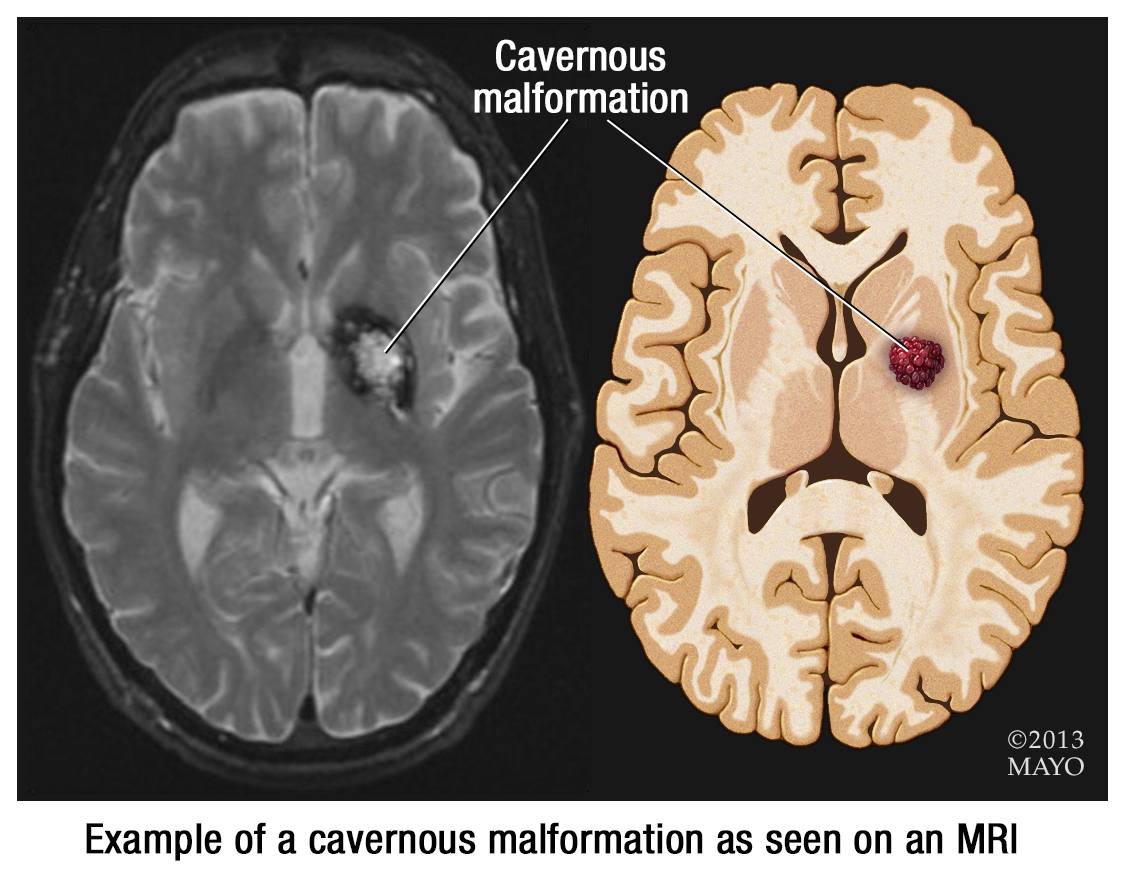-
Mayo Clinic named Center of Excellence for cavernous malformation treatment, research

ROCHESTER, Minn. — Mayo Clinic has been named a Center of Excellence by Angioma Alliance for treatment and research into cerebral cavernous angiomas.
These abnormally shaped blood vessels in the brain or spine have the appearance of raspberries or a small cluster of grapes. They can cause symptoms such as bleeding, seizures, motor problems, memory problems and muscle weakness. They go by many names, such as cerebral cavernous malformations, cavernous hemangiomas and cavernomas.
Cerebral cavernous malformations are rare, occurring in about 1 of every 500 to 600 people, or 0.2 percent of the general population, according to the Angioma Alliance. They can occur in children, but symptoms typically appear for the first time when a person is in his or her 20s or 30s.
“Cavernous malformations are rare ─ even to a neurologist or neurosurgeon,” says Kelly Flemming, M.D., a Mayo Clinic neurologist, who is medical director of Mayo’s Center of Excellence and a member of the Angioma Alliance Scientific Advisory Board. “Having coordinated care by providers familiar with the disease is very important to patients.”
Most cerebral cavernous malformations occur as a single formation, without an apparent cause and without any family history. Some occur following focal brain radiation therapy. But roughly 20 percent of affected people have an inherited form of the disorder.
For patients who aren’t experiencing symptoms, treatment may be observation to watch for changes in the malformation. For those experiencing seizures or other symptoms, treatment may include medications or surgery.
“It is important for patients to be evaluated in centers where there is in-depth expertise in all of the different aspects of their care,” says Giuseppe Lanzino, M.D., a Mayo Clinic neurosurgeon who is co-director of Mayo’s Center of Excellence.
Criteria for certification of Centers of Excellence were created by Angioma Alliance staff with input from patients. Centers of Excellence offer multidisciplinary care for patients who often are burdened with coordinating multiple appointments with different medical specialists.
Patients with cavernous malformation are seen at Mayo Clinic sites in Rochester, Phoenix and Jacksonville, Florida. Because of patient volume criteria, Mayo Clinic’s Rochester campus received the Center of Excellence designation.
“We are pleased to recognize the Center of Excellence team at Mayo Clinic for the outstanding care they have been providing to our patients,” says Connie Lee, Psy.D., president and CEO, Angioma Alliance. “We also appreciate the investment they have made in researching cerebral cavernous malformations, paving the way for better treatments in the future. Angioma Alliance sets a high bar for Centers of Excellence, and Mayo Clinic joins a select group that has surpassed our expectations.”
Drs. Flemming and Lanzino, and other Mayo Clinic investigators engage in research to try to identify the risk factors that increase the risk of bleeding from this condition.
###
About Angioma Alliance
Angioma Alliance’s mission is to inform, support and empower individuals affected by cavernous angioma and drive research for better treatments and a cure. Its mission is achieved through a variety of programs, including peer support, patient advocacy, a DNA/tissue bank to provide materials for the medical community, an Annual International Scientific Meeting and direct support of research that will lead to noninvasive cures for cerebral cavernous malformations.
About Mayo Clinic
Mayo Clinic is a nonprofit organization committed to clinical practice, education and research, providing expert, comprehensive care to everyone who needs healing. For more information, visit mayoclinic.org/about-mayo-clinic or newsnetwork.mayoclinic.org.
MEDIA CONTACT
Susan Barber Lindquist, Mayo Clinic Public Affairs, 507-284-5005, newsbureau@mayo.edu







